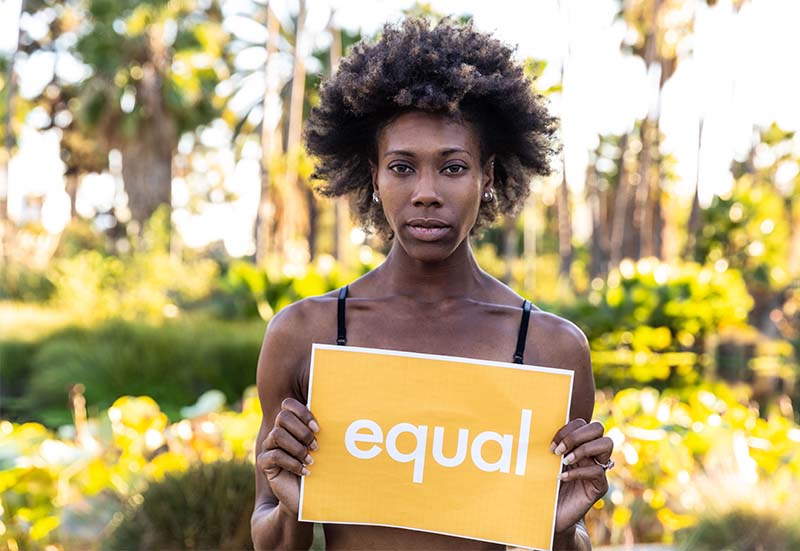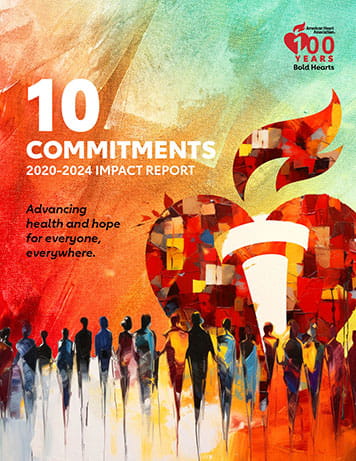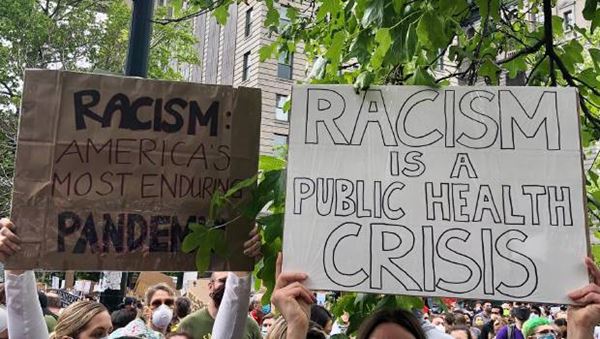Championing Health Equity
for All
for All

The American Heart Association’s 2024 Goal

Fulfilling Our Commitments
In 2020, we committed to 10 bold actions to address barriers to equitable health – because all people deserve to enjoy longer, healthier lives. Powered by our millions of volunteers and supporters, in just four years we’ve seen monumental success.
Learn more about this important work (PDF)(link opens in new window)
The Urgent Need for Health Equity
 For years we’ve been striving to ensure everyone has an optimal, just opportunity to be healthy. But this is not the reality for many people of color and others whose health suffers because of social factors beyond their control. In fact, people in some under-resourced ZIP codes have shorter life expectancies than their neighbors just a few miles away. And people in often-remote rural areas face significantly higher death rates from heart disease and stroke.
For years we’ve been striving to ensure everyone has an optimal, just opportunity to be healthy. But this is not the reality for many people of color and others whose health suffers because of social factors beyond their control. In fact, people in some under-resourced ZIP codes have shorter life expectancies than their neighbors just a few miles away. And people in often-remote rural areas face significantly higher death rates from heart disease and stroke.
COVID-19 has illuminated these unacceptable health disparities and worsened the problems. The pandemic and economic hardships have disproportionately harmed the health of Black, Latino and Native American people. That’s why our 2024 Impact Goal affirms our focus on identifying and removing barriers to health equity.
The Human Toll
These graphics show disproportionate death rates among people of color and people in rural areas.
Eliminating the Barriers to Health Equity
Social Determinants of Health

The conditions in which people live shaped by the distribution of money, power and resources.
Structural Racism

A system in which public policies, institutional practices, cultural representations and norms perpetuate racial inequity.
Mending Rural Health
People in rural communities get sicker and die sooner than people who live in urban or suburban areas. The AHA is determined to close this health care gap, through advocacy, education and by funding research.
A Closer Look at the Community Impact
Our Commitments
As champions of health equity, we’re committed to advancing cardiovascular health for all. We will not stand by while people get sick.
We will advance cardiovascular health for all. We will not stand by while people suffer. We won’t watch people get sick, die young and struggle. We will not tolerate structural racism, or the many social factors that hurt people’s health in rural and urban areas alike.
We’re taking bold actions – we call them our 10 Commitments – to remove barriers to health. As an organization that has relentlessly worked to save and improve lives for 100 years, we have faced urgent health crises before. And now, with the strength of our millions of volunteers, supporters, partners and collaborators, we are urgently doubling down at this unique point in history. Here are the commitments we are making to remove barriers to health equity through science, community investment, improvements to health care access and quality, advocating for change and more.
| 1 | Investing $100 million in new research programs and grants focused on science-based solutions to health inequities and structural racism. We also will expand diversity-research opportunities for underrepresented racial and ethnic groups in science and medicine through grant funding, STEM programs, and our HBCU and EmPOWERED to Serve Scholars programs. |
| 2 | Investing in community-led solutions to address health inequity and structural racism. Specifically, we will raise and invest at least $100 million to address the barriers to health equity at the community level through our Social Impact Fund, the Bernard J. Tyson Impact Fund, and our community issues campaigns, including Voices for Healthy Kids. |
| 3 | Improving access to and the quality of health care for under-resourced populations and those in rural communities, as part of our 50-state focus on Medicaid expansion. We also will dedicate our advocacy and community resources to secure this coverage in all states lacking expanded access. |
| 4 | Leveraging our advocacy, science and news media enterprise against companies targeting individuals in disadvantaged communities with unhealthful products including sugary beverages and tobacco products (including e-cigarettes) with addicting flavors and menthol. |
| 5 | Launching, in partnership with the U.S. Department of Health and Human Services (HHS), a $121 million-dollar nationwide hypertension initiative to address a main source of poor cardiovascular health in Black, Hispanic, and Indigenous communities, funded by the federal government. Under the partnership we will team with HHS to support select Health Resources and Services Administration (HRSA) funded health centers and associated communities. The collective aim is to elevate quality of care delivered in these Centers, provide evidence-based education to providers and clinicians, and engage patients with training to effectively control hypertension. AHA will also leverage and expand its existing hypertension programs in Federally Qualified Health Centers (FQHC). |
| 6 | Using our extensive clinical registry programs to capture data and create new scientific knowledge on the health effects of social determinants of health and health care quality variances among racial and ethnic groups, and reporting on this data regularly through our quality improvement programs. |
| 7 | Collaborating with our CEO Roundtable to architect a road map, conceptual framework, and related tools for employers to identify and dismantle practices and policies in the workplace that contribute to structural racism and health inequities, all based on the AHA Presidential Advisory Call to Action: Structural Racism as a Fundamental Driver of Health Disparities. |
| 8 | Creating a digital learning platform for clinicians, health professionals, and scientists with courses on issues of reversing structural racism and improving health equity in the delivery of health care, and courses on professional development of the science and clinical workforce. In our scientific meetings, we will continue pushing for a diversity of speakers and commentators. |
| 9 | Elevating the focus of our scientific journals, including Circulation and Stroke, on disparities, anti-racism, health equity, community engaged/community based participatory research and implementation science. We will ensure these topics are prioritized for publication, and we will assess the diversity of authors in our journals, including editorial commentaries. |
| 10 | Increasing the diversity of our workforce, including leadership. We are committed to filling at least one-third of hires with diverse individuals. We will mitigate bias in the recruitment, development, advancement and retention of diverse colleagues by providing ongoing learning and development experiences, leveraging our behavioral and integrated interviewing system, incorporating industry leading platforms and working with diverse alliance partners. |


